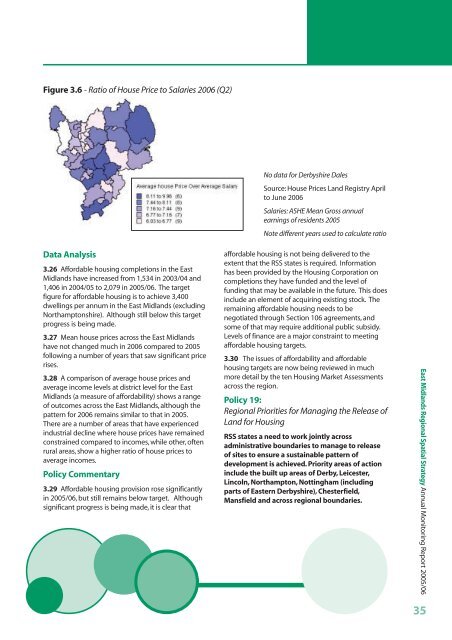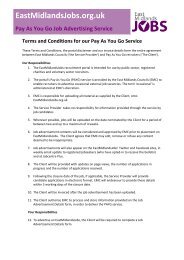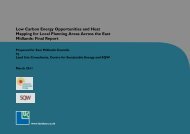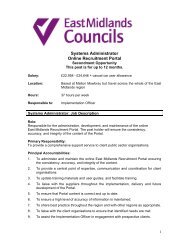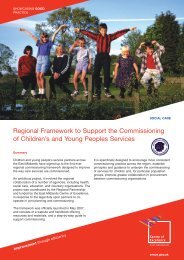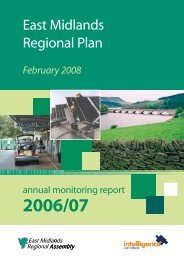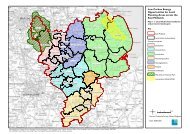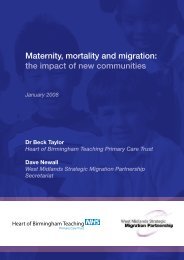East Midlands Regional Spatial Strategy 2005/06
East Midlands Regional Spatial Strategy 2005/06
East Midlands Regional Spatial Strategy 2005/06
You also want an ePaper? Increase the reach of your titles
YUMPU automatically turns print PDFs into web optimized ePapers that Google loves.
Figure 3.6 - Ratio of House Price to Salaries 20<strong>06</strong> (Q2)<br />
No data for Derbyshire Dales<br />
Source: House Prices Land Registry April<br />
to June 20<strong>06</strong><br />
Salaries: ASHE Mean Gross annual<br />
earnings of residents <strong>2005</strong><br />
Note different years used to calculate ratio<br />
Data Analysis<br />
3.26 Affordable housing completions in the <strong>East</strong><br />
<strong>Midlands</strong> have increased from 1,534 in 2003/04 and<br />
1,4<strong>06</strong> in 2004/05 to 2,079 in <strong>2005</strong>/<strong>06</strong>. The target<br />
figure for affordable housing is to achieve 3,400<br />
dwellings per annum in the <strong>East</strong> <strong>Midlands</strong> (excluding<br />
Northamptonshire). Although still below this target<br />
progress is being made.<br />
3.27 Mean house prices across the <strong>East</strong> <strong>Midlands</strong><br />
have not changed much in 20<strong>06</strong> compared to <strong>2005</strong><br />
following a number of years that saw significant price<br />
rises.<br />
3.28 A comparison of average house prices and<br />
average income levels at district level for the <strong>East</strong><br />
<strong>Midlands</strong> (a measure of affordability) shows a range<br />
of outcomes across the <strong>East</strong> <strong>Midlands</strong>, although the<br />
pattern for 20<strong>06</strong> remains similar to that in <strong>2005</strong>.<br />
There are a number of areas that have experienced<br />
industrial decline where house prices have remained<br />
constrained compared to incomes, while other, often<br />
rural areas, show a higher ratio of house prices to<br />
average incomes.<br />
Policy Commentary<br />
3.29 Affordable housing provision rose significantly<br />
in <strong>2005</strong>/<strong>06</strong>, but still remains below target. Although<br />
significant progress is being made, it is clear that<br />
affordable housing is not being delivered to the<br />
extent that the RSS states is required. Information<br />
has been provided by the Housing Corporation on<br />
completions they have funded and the level of<br />
funding that may be available in the future. This does<br />
include an element of acquiring existing stock. The<br />
remaining affordable housing needs to be<br />
negotiated through Section 1<strong>06</strong> agreements, and<br />
some of that may require additional public subsidy.<br />
Levels of finance are a major constraint to meeting<br />
affordable housing targets.<br />
3.30 The issues of affordability and affordable<br />
housing targets are now being reviewed in much<br />
more detail by the ten Housing Market Assessments<br />
across the region.<br />
Policy 19:<br />
<strong>Regional</strong> Priorities for Managing the Release of<br />
Land for Housing<br />
RSS states a need to work jointly across<br />
administrative boundaries to manage to release<br />
of sites to ensure a sustainable pattern of<br />
development is achieved. Priority areas of action<br />
include the built up areas of Derby, Leicester,<br />
Lincoln, Northampton, Nottingham (including<br />
parts of <strong>East</strong>ern Derbyshire), Chesterfield,<br />
Mansfield and across regional boundaries.<br />
<strong>East</strong> <strong>Midlands</strong> <strong>Regional</strong> <strong>Spatial</strong> <strong>Strategy</strong> Annual Monitoring Report <strong>2005</strong>/<strong>06</strong><br />
35


